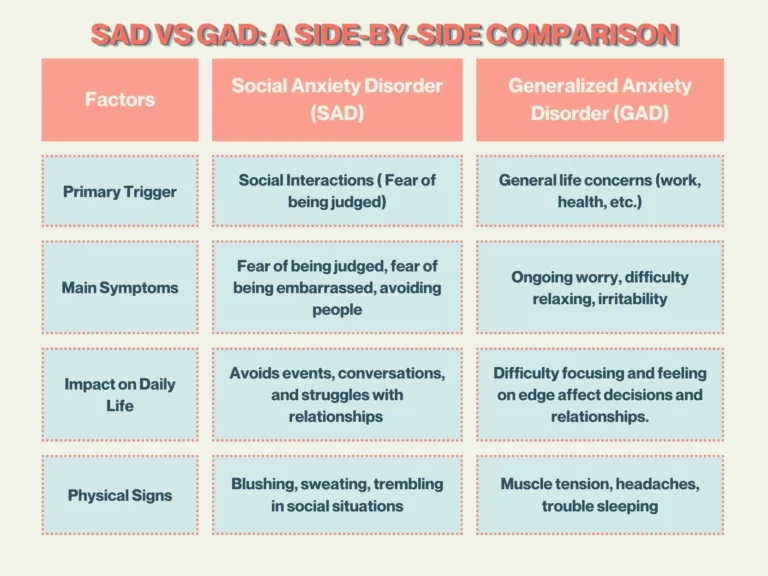Anxiety can take on many forms, but the two most common are Generalized Anxiety Disorder (GAD) and Social Anxiety Disorder (SAD).
While both disorders come with similar symptoms like overwhelming worry or fear, they can affect very different parts of your life.
We hope that by breaking down the differences between GAD vs SAD, you can better understand which one may be affecting your life.
This way, you can find the right treatment to help you manage your anxiety.
The Basics of Social Anxiety Disorder (SAD)
Social Anxiety Disorder (SAD) is a mental health condition characterized by an intense fear of social situations where one might feel judged, embarrassed, or scrutinized by others.1
Individuals with SAD often experience severe anxiety in settings like public speaking, meeting new people, or even casual interactions, which can lead to avoidance of these situations.
This fear goes beyond typical shyness, causing physical symptoms like sweating, trembling, or nausea.
SAD can significantly impact daily life, making it difficult to maintain relationships, pursue career goals, or engage in social activities.
Signs of SAD
Here are some common signs of Social Anxiety Disorder (SAD) that you may recognize:
- Intense Fear of Social Situations: Overwhelming anxiety about being judged or embarrassed in social settings.
- Avoidance of Social Interactions: Actively avoiding events, gatherings, or situations that involve others.
- Physical Symptoms: Sweating, trembling, blushing, or nausea in social or performance situations.
- Self-Consciousness: Excessive worry about how one is perceived by others, often feeling overly aware of actions or appearance.
- Difficulty Speaking: Trouble with speaking in groups or public settings, often due to fear of embarrassment.
- Negative Self-Talk: Persistent thoughts of inadequacy or fear of making mistakes in social situations.
- Anticipatory Anxiety: Experiencing intense worry or dread about upcoming social events, sometimes days or weeks in advance.
Anxiety Treatment Available at Cornerstone
Explore our residential, outpatient, and virtual pathways to mental health recovery here at Cornerstone Healing Center.

Understanding Generalized Anxiety Disorder (GAD)
Generalized Anxiety Disorder (GAD) is a mental health condition characterized by persistent and excessive worry about various aspects of daily life, such as work, health, or relationships.2
Unlike normal anxiety, which may be situational and temporary, GAD involves chronic anxiety that is often disproportionate to the actual circumstances.
This constant state of worry can lead to physical symptoms, such as fatigue, muscle tension, and difficulty concentrating.
Individuals with GAD may find it challenging to control their worry, which can interfere with daily activities and overall well-being.
Signs of GAD
Here are some common signs of GAD to help you identify:
- Excessive Worry: Persistent, uncontrollable worry about various aspects of life, even when there’s no immediate threat.
- Restlessness: Feeling on edge or unable to relax.
- Fatigue: Constant tiredness, even after a full night’s rest.
- Difficulty Concentrating: Trouble focusing on tasks due to racing thoughts.
- Irritability: Becoming easily frustrated or agitated.
- Muscle Tension: Tightness or aches in muscles, often in the neck, shoulders, or back.
- Sleep Disturbances: Trouble falling asleep, staying asleep, or feeling rested after sleep.
Comparing GAD vs SAD: Key Differences to Know
Recognizing the differences between GAD vs SAD can be challenging, as both bring significant anxiety.
What helps set them apart are the specific triggers and how they can impact your daily life.
SAD centers around social interactions, often causing you to avoid events or feel uncomfortable in public.
GAD, on the other hand, involves a broader range of everyday worries that can leave you feeling constantly on edge.
Below is a side-by-side comparison to help highlight these key differences:

When to Seek Professional Help
If symptoms of Generalized Anxiety Disorder (GAD) or Social Anxiety Disorder (SAD) are affecting your day-to-day life, relationships, or work, it may be time to seek professional help.
Anxiety that becomes overwhelming can drain emotional and physical energy, making even routine activities difficult to manage.
Fortunately, a range of treatment options exists to address these challenges and offer lasting relief.3
Treatment Options
Therapies are a primary treatment option for both GAD and SAD, and several approaches offer unique benefits:
- Cognitive Behavioral Therapy (CBT): CBT is a leading therapy for GAD and SAD, helping individuals identify, challenge, and reframe negative thought patterns and behaviors that contribute to anxiety.4
- Exposure Therapy: Often recommended for SAD, exposure therapy involves gradual exposure to feared social situations, reducing anxiety over time through controlled, repeated experiences.
- Acceptance and Commitment Therapy (ACT): ACT focuses on accepting anxious thoughts without letting them influence behavior, encouraging individuals to live in alignment with personal values.
- Mindfulness-Based Stress Reduction (MBSR): MBSR incorporates mindfulness techniques that help individuals stay present and grounded, reducing anxiety and the mental “chatter” that often accompanies it.
- Group Therapy: For individuals with SAD, group therapy provides a safe space to build social skills and connect with others experiencing similar challenges.
Medication can also be helpful for managing symptoms, particularly when combined with therapy. Common medications include:
- Antidepressants: Selective serotonin reuptake inhibitors (SSRIs) and serotonin-norepinephrine reuptake inhibitors (SNRIs) are frequently prescribed for GAD and SAD due to their effectiveness in managing symptoms.
- Anti-Anxiety Medications: Medications like benzodiazepines may be used short-term for acute anxiety, but they are generally not recommended for long-term management due to potential dependence.
- Beta-Blockers: Sometimes prescribed for SAD, beta-blockers can help manage the physical symptoms of anxiety, such as a racing heart or shaking, especially in social or performance situations.
Seeking professional help provides a pathway to effective treatments tailored to your needs. Through therapy, medication, or a combination of both, individuals can gain control over their anxiety and work toward a balanced, fulfilling life.
Quick Tip: Track Your Anxiety Patterns ✍️
Daily Techniques to Help Manage GAD vs SAD
While professional treatment is key, there are also practical steps you can take to manage your anxiety on a daily basis.
Here are some simple tips to help you cope with both GAD or SAD:
- Mindful Breathing: Spend a few minutes focusing on slow, deep breaths to calm your mind.
- Exercise: Walking or yoga, can reduce stress and boost your mood.
- Positive Self-Talk: Reminding yourself of more positive or realistic outcomes, can help reduce negative thoughts.
- Relaxation: Try meditation or muscle relaxation exercises to ease tension and anxiety.
Techniques for Managing SAD
For coping techniques specific to help manage Social Anxiety Disorder (SAD) :
- Small Social Goals: Start with small, manageable interactions, like a brief chat with a colleague, and gradually work your way up to more challenging social settings.
- Cognitive Restructuring for Social Situations: Change the way you view social interactions. Instead of expecting judgment from others, practice seeing these situations in a more balanced and less threatening way.
Techniques for Managing GAD
For those managing Generalized Anxiety Disorder (GAD), here are some techniques that can help:
- Problem-Solving for Everyday Worries: Focus on what you can control by breaking down your worries into manageable steps instead of getting caught up in endless “what if” scenarios.
- Mindfulness for Constant Worry: Mindfulness can be particularly helpful for GAD, where anxiety spans multiple areas of life. It helps you stay focused on the present and reduces excessive worry about the future.
No matter what type of anxiety disorder you may have, practicing some of these daily techniques can make all the difference.
With professional guidance and these daily techniques, you can take meaningful steps toward living a well-balanced life.
Frequently Asked Questions
Can You Be Diagnosed with Both GAD and SAD?
Yes, it’s possible to be diagnosed with both GAD and SAD. These two disorders can coexist, with GAD involving general worry and SAD involving anxiety specifically related to social interactions. A mental health professional can help you determine the best course of treatment if you experience symptoms of both.
Do I Have GAD or Just Anxiety?
GAD is a specific type of anxiety disorder that involves excessive, long-term worry about various aspects of life. If your anxiety is constant and affects multiple areas of your life, you may have GAD. Consulting a therapist or doctor can help you determine whether you’re dealing with GAD or general anxiety.
What Are the Main Differences Between GAD and SAD?
The primary difference between GAD and SAD is the focus of the anxiety. GAD involves excessive worry about a wide range of everyday situations, while SAD is triggered by fear of judgment or embarrassment in social situations. Both disorders can significantly affect quality of life but manifest in different ways.
What Are Common Treatments for GAD and SAD?
Both GAD and SAD can be treated with a combination of therapy and, in some cases, medication. Cognitive Behavioral Therapy (CBT) is often used to help individuals reframe negative thought patterns. Medications like antidepressants or anti-anxiety medications may be prescribed to manage symptoms. Consulting a mental health professional is the best way to determine the right treatment for your needs.
Key Takeaways
- Key Takeaways
- GAD and SAD both involve anxiety, but their triggers and impact on daily life differ significantly.
- Recognizing whether you have GAD vs SAD is the first step toward seeking appropriate treatment.
- Daily techniques, like mindful breathing and small social goals, can help manage anxiety alongside professional support.
- Early intervention and a proper diagnosis are essential to improving your overall well-being and quality of life.
Take the First Step Towards Managing Your Anxiety
Understanding the differences between Generalized Anxiety Disorder (GAD) and Social Anxiety Disorder (SAD) is crucial in choosing the right support and treatment.
GAD is marked by persistent worry about various aspects of life, while SAD involves intense fear of social situations and potential judgment.
Both conditions can affect your quality of life, but with the proper therapy and guidance, managing and alleviating anxiety symptoms is achievable.
If anxiety is impacting your daily life, whether through GAD, SAD, or both, Cornerstone Healing Center is here to provide support.
We offer specialized mental health treatment programs, including personalized care for anxiety disorders, to help you build resilience and reclaim control.
Our compassionate team is dedicated to guiding you on your path to better mental health—contact us today to learn more about how you can get started.






